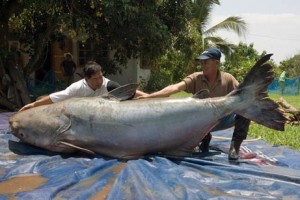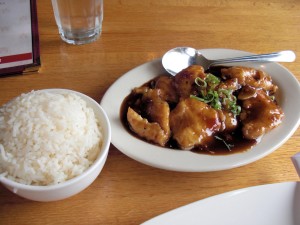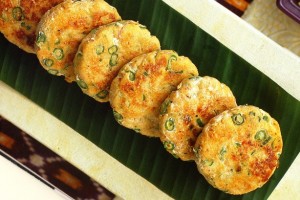By Dave DeWitt & Mike Stines
From Thailand: Deep-Fried Curried Fish Patties and Thai Baked Stuffed Chile Peppers
From Singapore: Singapore Fried Prawns with Dried Chile
From Vietnam: Fish with Ginger Salsa
From Borneo: Tangy Marinated Fish
From Cambodia: Tantalizing Catfish
The Mekong Catfish above is a good example of why some catfish and groupers are called “the pigs of the sea.” Freshness is the key to Asian seafood, and many of the fish are sold live from tanks similar to the ones used for lobsters. Most of the ingredients can be found in well-stocked markets or Asian specialty shops. If not, ImportFood.com is a good source for fresh Indonesian products by mail.
Hot and Sour Flounder (Acar Ikan)
Jeff Corydon collected this recipe in Indonesia. He found the area endowed with coastal waters, lakes and rivers. “Acar” refers to the pungent sweet and sour vegetables or relish typical of the region.
1 (2-pound) whole flounder
1 teaspoon coarse kosher salt
1 teaspoon ground cayenne
4 dried cayenne chiles, seeded, soaked in water until soft, and chopped
3 cloves garlic, minced
1 large onion, chopped
3 macadamia nuts
1 teaspoon ground ginger
1 teaspoon ground cumin
1/2 cup vegetable oil, divided
1/2 cup cider vinegar
1 teaspoon dry mustard
1 teaspoon granulated sugar
1 cup water
Clean the fish, remove the head, but leave the skin on. Firmly rub some salt and cayenne pepper into both sides of the fish.
Place the chiles, garlic, onion, nuts, ginger and cumin in a blender or food processor and process.
Heat 2 tablespoons of the oil in a large skillet or wok and fry the chile paste over low heat for 2 to 3 minutes, stirring constantly. Add the vinegar, mustard, sugar and water; simmer, uncovered, for 15 minutes.
Meantime, heat the rest of the oil in another skillet and fry the fish over medium heat until both sides are golden brown.
Combine the fish with the sauce in the large skillet and simmer 2 to 3 minutes over low heat, basting frequently with the sauce. Serve immediately.
Serves: 4 to 6
Heat Scale: Hot
Deep-Fried Curried Fish Patties with Cucumber Relish (Thod Mun Pla)
What an exciting combination of foods are in this recipe! The delicate flavor of the trout and the complexity of the red curry offer an aromatic and pungent Thai delight.
2 tablespoons red curry paste
1 tablespoon finely shredded kaffir lime leaves
5 fresh Thai chiles, seeded and chopped
3 tablespoons Thai fish sauce (Nam Pla)
1 teaspoon brown sugar
1/4 teaspoon ground black pepper
1 egg
1 cup finely diced or puréed long or string beans
1 cup minced or puréed Thai basil leaves
Cooking oil
Cucumber relish (recipe follows)
In a large bowl, mix all the ingredients except the oil together until all the ingredients are well mixed. Form the mixture into small patties.
Using a wok heat two to three inches of oil to 350 degrees F. Fry the patties until they turn golden brown. Remove them from the hot oil and drain well on paper towels.
In Thailand, fish patties are always served with cucumber relish.
Serves: 4
Heat Scale: Hot
Cucumber Relish
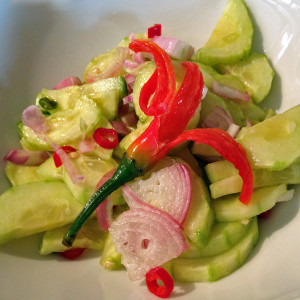
1/4 cup water
1/2 teaspoon salt
1 cup granulated sugar
1/4 cup thinly sliced shallot
1 large cucumber, peeled, seeded and sliced
1 Thai chile, seeded and finely chopped
Sprigs of cilantro for garnish
In a large bowl, mix all the ingredients except the oil together until all the ingredients are well mixed. Form the mixture into small patties.
Using a wok heat two to three inches of oil to 350 degrees F. Fry the patties until they turn golden brown. Remove them from the hot oil and drain well on paper towels.
Singapore Fried Prawns with Dried Chile
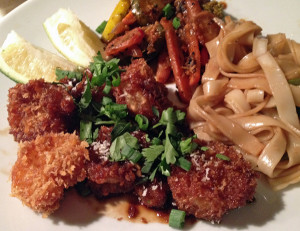
Here is a Singapore classic featuring prawns. Prawns (fresh water shrimp) are used extensively in Asian cooking, and are dried, ground and processed into various types of pungent pastes. The use of twelve cayenne chiles in the sauce for this recipe will definitely give your guests a thrill! Large shrimp could be substituted for prawns.
Sauce:
12 dried cayenne peppers, seeded and crushed
1/4 cup rice wine
1 tablespoon vegetable oil
2 teaspoons granulated sugar
1 teaspoon soy sauce
4 thin slices fresh ginger
4 diagonal-cut thin slices green onion
1 clove garlic, minced
1/4 teaspoon cornstarch mixed with 1/2 teaspoon cold water
Dash of dark soy sauce
For the sauce, combine all the ingredients in small saucepan over high heat and stir until the mixture thickens slightly.
Prawns:
1 tablespoon cornstarch
1 teaspoon light soy sauce
2 eggs, beaten
2 tablespoons panko bread flakes
1/2 teaspoon coarse kosher salt
3 dried piquin chiles, seeded and crushed, or substitute other small, hot dried chiles
Freshly ground black pepper
1 pound large prawns, shelled and deveined
Vegetable oil for deep frying
For the prawns, combine the cornstarch and soy sauce in a small bowl and blend until smooth. Add the eggs, flour, salt, piquins and pepper; blend thoroughly.
Heat the oil in large saucepan or deep-fat fryer to 400 degrees F. Meanwhile, pat the prawns dry with paper towels. Dip the prawns into the batter, then drop gently into the oil and fry for about two to three minutes or until they float. Remove the prawns with a slotted spoon and drain well on paper towels.
Add the prawns to the sauce in batches, stirring just enough to coat. Transfer to a platter and serve immediately with rice or spicy Lo Mein.
Serves: 2 to 3
Heat Scale: Extremely Hot
Thai Baked Stuffed Chile Peppers (Prik Chee Sy Moo)
This low-calorie dish is from Thailand. Although these chiles are not battered or fried, this recipe reminds one of chile rellenos, the stuffed green chile dish of the American south west. Haddock or halibut could be substituted for the snapper.
8 fresh New Mexican green chiles, stems on
3/4 pound snapper fillets, minced
1/3 cup water chestnuts, finely chopped
1 egg white, lightly beaten
2 green onions, minced
2 teaspoons peanut oil, divided
2 teaspoons soy sauce
Roast the chiles on a hot grill or in a broiler on high heat. Turn them occasionally until the skins are blackened and charred. When the skin of the chiles is sufficiently charred and blistered, remove from the heat and place in a bowl. Cover with plastic wrap and let them cool to room temperature. Peel the skin from the cooled chiles. Be careful to not tear the chile. Cut a lengthwise slit in each chile and carefully remove the seeds.
In a bowl, combine the fish with water chestnuts, egg white, green onions, 1 teaspoon oil and soy sauce. Mix well.
Carefully spoon the fish filling into the slit to avoid splitting. Place in a baking dish sprayed with non-stick vegetable coating; brush chiles lightly with oil.
Bake at 350 degrees F. for 30 minutes or until the chiles are tender and filling is cooked to 140 degrees F.
Serves: 4
Heat Scale: Mild
Tangy Marinated Fish (Umai)
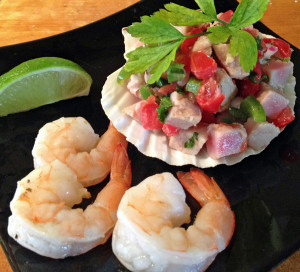
The key to this Borneo recipe is to use the freshest fish possible. The Latin American version of this dish would be ceviche, which also cooks the fish with lime juice. Fresh scallops or shrimp could be substituted.
1/2 cup freshly squeezed lime juice (or more if needed)
1 pound extremely fresh fish fillets (Spanish mackerel preferred but mahi-mahi or tuna could be used), cut into 1/2-inch pieces
3 serrano or jalapeño chiles, seeded and chopped
1 teaspoon coarse salt
8 shallots, thinly sliced
1 (2-inch piece) ginger, peeled and grated
2 sprigs cilantro, chopped
2 sprigs celery leaves, chopped
Reserve 2 tablespoons of lime juice. Marinate the fish in the remaining juice for at least 30 minutes, stirring once or twice, until the fish turns white. Drain and discard the lime juice.
While the fish is marinating, pound the chiles with the salt until a paste is formed. When the fish is ready, mix it with the chile paste, shallots, ginger, fresh cilantro, celery and reserved lime juice. Taste and add more salt if desired. Serve immediately.
Serves: 3 to 4
Heat Scale: Medium
Tantalizing Catfish (Amok)
Cambodian cooking is very similar to Thai cooking, which shares the influence of Vietnam, China and Indonesia. It can be characterized by the uses of lemongrass, galangal, ginger, garlic and many fresh water fish, most of which are not available in the United States. We have used snapper in this recipe, as it bears a close resemblance to its Indonesian counterpart (Basa or Swai). This recipe requires advance preparation.
1 teaspoon thin slices peeled galangal
1 clove garlic, peeled
1 1/2 tablespoons finely julienned kaffir lime leaves
1/4 teaspoon turmeric powder
1/4 cup minced lemongrass
5 dried piquin chiles, seeded and soaked 10 minutes in lukewarm water, chopped fine
2 tablespoons fish sauce (Nam Pla)
1 egg, well beaten
2 tablespoons granulated sugar
2 cups coconut milk (not coconut cream)
1 1/2 pounds snapper (or catfish or trout) fillets, sliced into strips 1/2-inch thick
8 banana leaves, cut 14 inches by 10 inches
1/2 pound fresh spinach, stems removed
In a blender or food processor, combine the galangal, garlic, one teaspoon of the kaffir lime leaves, turmeric, lemongrass, chiles, fish sauce, egg, sugar and coconut milk. Process, scraping the sides of the container occasionally, until ingredients are puréed.
Combine the contents of the blender and the catfish in a glass bowl, coating the fish thoroughly. Cover and refrigerate at least 5 hours or overnight.
Put one piece of banana leaf atop another, to make a double thickness. Place one quarter of the spinach leaves into the center and top with one-quarter of the fish mixture (about one cup). Garnish with a pinch of julienned kaffir lime leaves. Fold the two layers of banana leaves lengthwise in thirds, then fold the ends up to the top and secure with toothpicks. Keep the sides up to prevent leaking. Repeat the procedure, making four packages.
Place the bottom rack of a 9- or 10-inch bamboo steamer in a wok and pour in enough water to come to about an inch below the steamer. Put two fish packages on the bottom rack. Fit a second rack above it and put on the remaining two packages. Cover and place over high heat for about 5 minutes to bring to a boil. Reduce the heat to medium low and cook for 45 minutes. To serve, remove the toothpicks and open the packages.
Serves: 4
Heat Scale: Medium
Fish with Ginger Salsa
This recipe is from Contributing Editor Richard Sterling. Richard has spent many years in Southeast Asia, and collected this recipe on one of his trips back to Vietnam. Cod, haddock or mahi-mahi fillets could be substituted for the whole snapper.
1/4 teaspoon salt
1/2 teaspoon ground black pepper
1 teaspoon granulated sugar
4 teaspoons Vietnamese fish sauce (Nuoc Mam)
12 large basil leaves
1 whole snapper, about 2 pounds, cleaned, head and tail left on
4 cloves garlic, minced
1 tablespoon grated ginger
1 serrano or jalapeño chile, seeded and minced
2 tablespoons lime juice (1 lime)
Vietnamese dipping sauce (Nuoc Cham), recipe follows
Combine the salt, pepper, sugar and fish sauce, and sprinkle it over the fish. Marinate for 30 minutes on a plate spread with the basil leaves.
Combine the garlic, ginger, chile and lime juice; spread evenly on the top of the fish. Transfer the fish and the plate to a steamer and cook for 30 minutes.
Serve with dipping sauce.
Serves: 4
Heat scale: Mild
Nuoc Cham
3 tablespoons fresh lime juice
2 tablespoons granulated sugar
1/2 cup water
2 1/2 tablespoons fish sauce
Optional additions:
1 small garlic clove, finely minced
1 or 2 thinly sliced Thai chiles
Combine the lime juice, sugar and water. Stir to dissolve the sugar.
Add the fish sauce and any of the optional ingredients.
(Makes 3/4 cup)

